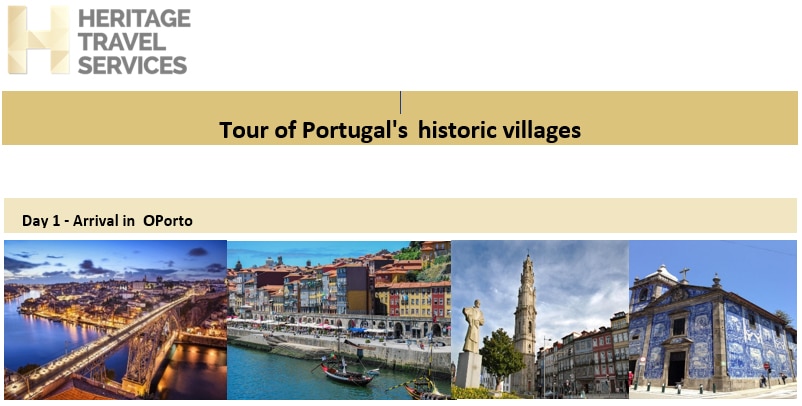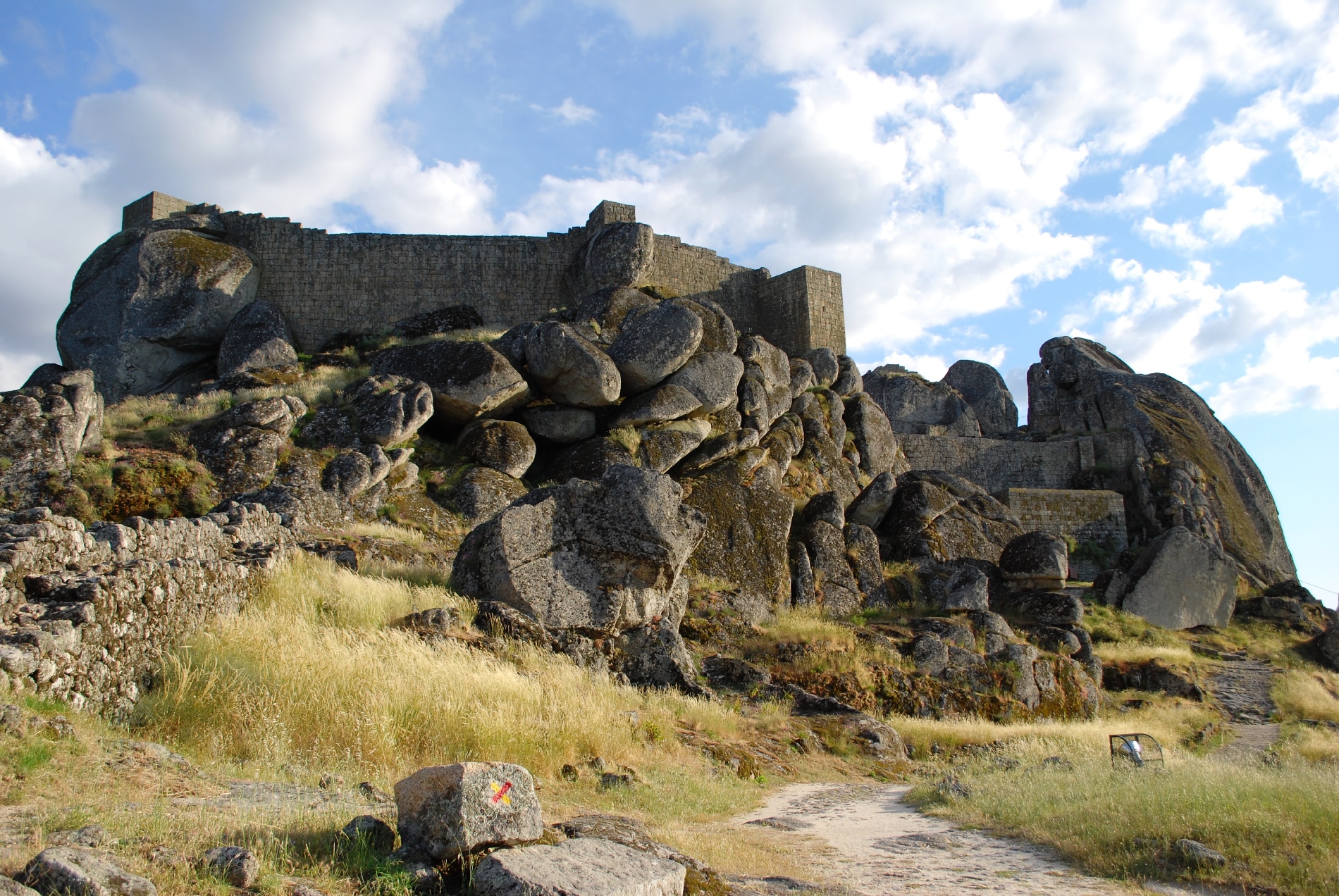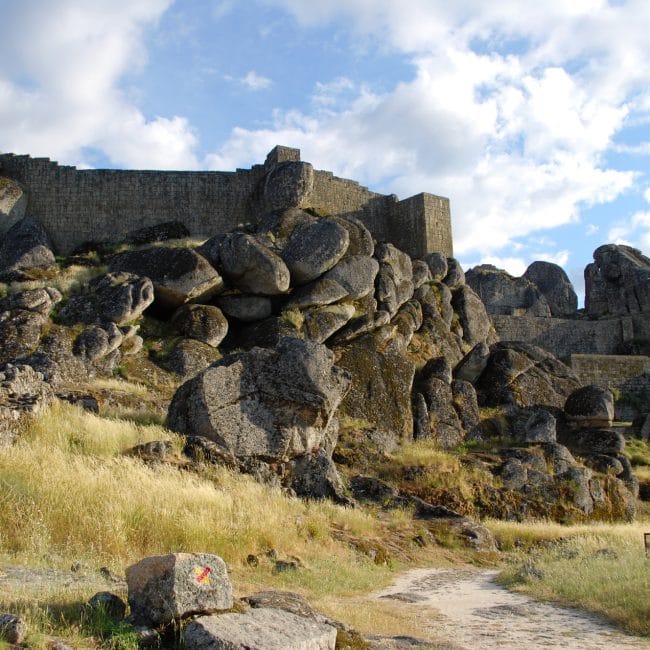HISTORICAL VILLAGES
They are small villages, authentic fairy tales that are located next to the Spanish border.
The Historical Villages of Portugal, are considered one of the most beautiful in the country and are the result of several generations of kings who, concerned with the defense of the territory, took charge of populating and fortifying that region.
Thus they were born next to these places whose nature is of undeniable beauty: Castles, churches, chapels, monuments and more recently, interesting museums that portray the rich material and immaterial heritage of the region.
Visiting the Historical Villages is a dream of a different and peaceful tourism.
Heritage Travel Services
See Portugal as you never saw
Tour Plan

Welcome to Oporto!
You will be received by a Heritage Travel Services representative. Transfer from the airport, followed by a panoramic tour of the city.
Free lunch.
Departure in the afternoon to visit the city of Oporto: Charming, located on the slopes of the Douro river, already near its mouth. Ranked as a World Heritage Site by UNESCO thanks to its beautiful monuments and historic buildings, such as the imposing Sé or the Torre dos Clérigos, Oporto is the second largest city in Portugal and has excellent views of the famous Port wine cellars, on the riverfront bank, in Vila Nova de Gaia. Although largely industrialized, Oporto offers a harmonious synthesis of ancient and contemporary attractions.
We can see: Cathedral (Oporto) - The imposing Cathedral of Oporto was completed in the thirteenth century, although it has undergone many changes over the centuries. With beautiful carvings, paintings, sculptures, treasures of sacred art and a romanesque rose, in addition to the beautiful baptismal chapel, covered with polychrome marbles and beautiful baroque tiles in the cloister and balcony, this is certainly a fascinating monument. Torre dos Clérigos (Oporto) - This Baroque-style bell tower was completed in 1763 and dominates the old city centre. The House of Music designed for the European Capital of Culture event of Oporto in 2001, Casa da Música is a dynamic and modern concert hall dedicated to the creation and celebration of music. Palacio de la Bolsa de Valores (Oporto) Exhibiting an imposing neoclassical facade, the old Palácio da Bolsa do Porto was built in the 19th century. Among others we visit: Livraria Lello is a living gateway to history: for the preservation of the building, for the maintenance of its original function as a bookstore, for the role of ambassador of culture and for the cultural dynamics that continues to be printed in the city.
Dinner and hotel accommodation in Oporto.
Day 2 - Oporto | Linhares da Beira | Trancoso
In the morning After breakfast, departure to Linhares da Beira,to start the tour the historic villages. Made of granite and shale, the historic villages preserve stories of ancient conquests and traditions, and dazzle for their landscapes, heritage and the sympathy of the people who inhabit them. Perched on the mountains, they are distinguished in the distance by the charming towers of their medieval castles. That's why they are strategically located along the border. Kings and landowners knew they could sleep more peacefully. Although sometimes they were wrong. Moors and Christians, Castilians and Portuguese, all of them tried to take them and, therefore, each has a very old story or a legend to tell. Today there reigns peace and the stones of the streets and houses retain the most genuine thing about Portugal: the authenticity of its people and the pride of a history of 900 years old.
Linhares da Beira already in the Serra da Estrela, thecity is crowned by the vigorous castle, harmonious with the geology of the terrain, on a huge rocky mountain from which you can see a spectacular panorama. Rebuilt in the thirteenth century by King D. Dinis, probably on the ruins of a Moorish fortification, it was an advanced bulwark in the defense of the Beira, site from which all the movements around them were monitored. Two large towers rise next to the angles of the wall, one turned east, the other to the west. In the square it is still possible to see the ruins of ancient cisterns. Nor should we miss the main church of Romanesque origin and which keeps tables attributed to Grão Vasco, an important painter of the sixteenth century, of granite houses, is a real-time trip. Among the must-see places are its majestic castle, the Diving Fountain and the Medieval Forum, the Jewish House, the old Inn, the Mother Church, the Pillory and the Old House of the Chamber and the Chain.
Then we continue to Trancoso,a land of the legendary "poet, prophet and shoemaker" Bandarra. Its privileged location, between the Douro, Côa and Mondego rivers, was a box of disputes since time immemorial. It was considered central to the Romans, it was bastion in the crisis of the reconquest- and stage of the famous Battle of Trancoso, in which as the Portuguese forces are the heavy defeat of the Castilian forces, which served in the Battle of Aljubarrota prelude. Start your visit through the wonderful Porta d'El Rei, or perfect starting point to explore or walled historic center of Trancoso, which not a distant year ago of 1281 as marriages of D. Dinis with Isabel de Aragon.
Walking in a hurry through the medieval streets, dazzled by a grandeur of Paços do Concelho and the Doge's Palace, admire his work Pelourinho, visit as beautiful Churches of São Pedro and Santa Maria, through walls without pejo through the Gates of the Prado, Carvalho and Traiao, discover the Jewish heranca of Trancoso in the Center of Jewish Culture Isaac Cardoso, stop finding or small Boeirinho and finish visiting at the top of the elevation to the Castle of Trancoso, two more in Portugal.
Dinner and hotel accommodation.
Day 3 - Marialva| Castelo Rodrigo | Almeida
Breakfast at the hotel. Today begins the day with a visit to the small town of Marialva, crossing point of the ancient Camino de Santiago. But what is lacking in size increases in authenticity. Marialva, because of its splendid location on a rocky mountain difficult to access, on the left bank of the Alva River, the small village of Marialva was an important military square in the Middle Ages. It is a population with very old roots, already inhabited in the 6th century BC. To the tribe of the Aravos. It was occupied successively by Romans (who gave it the name Civitas Aravorum), by Suevos and Arabs who settled in their defensive castro. Ferdinand The great, king of León, conquered her in 106 and gave it the name Malva, later Marialva. It is also said that the king of Portugal, D. Afonso II donated the population in 1217 to a lover of his, Ms Maria Alva, who would give rise to the name of the village. The castle was re-built by D. Sancho II of Portugal, in the year 1200 approximately, on the ruins of the Romanized castro. It is intimately linked to tragédia dos Távoras, because during the regicide against D. José I, his warden was precisely Marqués de Távora. Such fact led to a mob to abandon cidadela that there was in the interior of the castle. That is precisely why today the citadel is in ruins, and to make you feel the weight of history better, the decision has been made not to regain them. He believes that walking through the narrow alleys of the village and visiting the ruins of the citadel inside the high castle, balanced on top of a granite rock, will make you retreat, almost instantly, in time. Medieval causeways surrounded by Gothic walls and doors, lead to a small square where there is an elegant granite pelourinho, from the fifteenth century, the old dungeons and the court. The parent church, with a Manueline portal, is dedicated to Santiago and data from the sixteenth century, with its Manueline portal, the Church of São Pedro, the Cisterna of the sixteenth century, the old Palaces of the Municipality and the Solar dos Marqueses de Marialva.
We continue to Castelo Rodrigo that seems to be taken from a medieval film. When you can see its ancient walls in the distance, from which the tower towers sprout, and the golden houses settle on the hill, it is love at first sight. It is really very easy to see why it was considered one of the 7 Wonders of Portugal. Crossing the iconic Porta do Sol is like crossing a portal between two worlds. Castelo Rodrigo has more than a handful of monuments worth visiting. Among the most emblematic are the Castle, the Towers and the Pelourinho, the Medieval Cisterna, the Mother Church and the ruins of the Cristóvao Palace of Moura. But the best Castle Rodrigo is to walk selfishly through its medieval streets and discover the small details that give it color, such as the inscriptions and Hebrew crosses carved in the shoulder pads and staves of the gates, marks of the presence of Jews and new Christians that time has not erased.
Then we continue to Almeida. Almeida is one of the best specimens of bulwark fortification in Portugal, of which the stone walls surrounded by a very wide moat that made it difficult for the invaders to pass, the strategically placed bulwarks that allowed the observation of the entire surrounding territory, the three open doors in tunnel and vaulted, the false doors to deceive the invaders, the underground housematas that, equipped with all kinds of services necessary for survival in the event of war, could serve as a shelter to the entire population.
Almeida was the scene of struggles over the centuries, highlighting the Wars of the Restoration (seventeenth century), in which the Spaniards were definitively removed from the throne of Portugal, and the French invasions in the nineteenth century in which it was enclosed for a long period by Napoleonic troops, being their castle and part of the wall severely damaged by the explosion of a huge amount of powdered powders , which provoked his surrender. Inside the fortification, it is worth visiting the harmonious set of houses, and numerous religious and civil buildings scattered through narrow streets that preserve the atmosphere of other times.
Dinner and hotel accommodation.
Day 4 – Castelo Mendo | Belmonte
Breakfast at the hotel. Departure to Castelo Mendo. Built on top of a mountain on a strategic defense point, on trace elements dating from the Bronze Age and Roman times, Castelo Mendo is a historic village surrounded by walls rebuilt in the 12th century by order of D. Sancho I King of Portugal. The name of the town is due to the first governor D. Mendo Mendes appointed by D. Dinis in the 14th century, being possible to distinguish on one of the walls of the old Casa da Cadeia (prison) a stone sculpture, which according to popular tradition represents Mendo, and in another nearby house the representation of Menda, being therefore designated Casa da Menda, which would be the wife of Mendo.
The town surrounded by walls with six medieval gates (the main one flanked by 2 stone radiacs), consists of simple houses in stone, originally two floors, the ground floor being destined for cattle, and the upper floor to housing. The extremely narrow streets facilitated the defense of the population that was the scene of struggles during the wars in which Portugal participated, especially those that faced the Portuguese and the Spanish.
Recently the village has been restored, thus recovering some of the original features, constituting a true journey into the past through the walls that surround it.
We continue to Belmonte, the birthplace of Pedro Álvares Cabral, the Portuguese navigator who discovered Brazil. In addition to the strong connection with the Discoveries, Belmonte also has a huge connection with the Portuguese Jewish community belonging even to the Network of Jewish Women of Portugal. Get to know the full history of the powerful Cabral family and the discovery of Brazil by visiting Belmonte Castle (with its Manueline window), the Church of Santiago and the Pantheon of Cabrais and the modern Museum of Discoveries, installed in the Solar dos Cabrais.
Visit Largo do Pelourinho to see the historic Palacio del Condado and walk through the cobblestone streets of the Jewish quarter. Visit the Jewish Museum and bet Eliahu Sinegoga. A true journey through the past (and present) of Portugal's largest Jewish community.
End the day with a visit to the enigmatic Centum Cellas in Colmeal da Torre. The last excavations say that it was a Roman villa with origins in the 1st century A.D., but in its famous Tower no one knows for sure the purpose. See centum cellas sunset, with serra da Estrela on the horizon, is pure magic.
Dinner and hotel accommodation.
Day 5 - Sortelha | Monsanto
Breakfast at the hotel. Departure to Sortelha. Crowned by a castle built in a formidable rocky ensemble at 760 m altitude, Sortelha keeps its medieval appearance intact in the architecture of its granite cottages. Sortelha towards part of the important defensive line of border castles, built or rebuilt for the most part on castros of ancient Iberian civilizations and its name derives from the configuration of the land in steep rocks that surround the ring-shaped village (sortija, in Spanish), being built the walls also in circular form.
The entrance consists of a Gothic door on which you can see a balcony (Varanda de Pilatos), with openings (kill-coes) through which all kinds of projectiles were launched against the attackers. Before the entrance, a beautiful pelourinho deserves our attention, topped by the armillary sphere, symbol of D. Manuel I and the building in which the Paços do Concelho operated, both from the time of that king. On the lintel of another door, turned to the west, two grooves in the stone represent metric measurements (the largest, a "vara" and the smallest a "c'shea"), which served as a reference to medieval traders, at a time when the metric systems were not standardized. In the parent church, from the 14th century, there is an interesting work on the Spanish-Arab ceiling and the gilded carving of the main altar, added in the Baroque era.
The charm of this village lies in its medieval atmosphere, in which the houses, all built of granite stone and generally single-story, are based on the rock and harmonize with the topography of the land. Outside the walls grew another modern village, unfortunately in architectural molds deraised from tradition. Around Sortelha the landscape possesses the rough beauty of the large granite stones and the chestnut forests that accompany them.
We continue to Monsanto. It is said that the population resisted in this bulwark, for 7 years, the fence established by the Romans in the 2nd century BC, a feat that originated the Feast of the Crosses, which the village commemorates every year on May 3. In the 12th century, D. Afonso Henriques donated the conquered population to the Moors to the Order of the Templars, whose Master in Portugal, Gualdim Pais ordered the reconstruction of the castle. The village presents one of the most interesting human landscapes that can be found in Portugal. The agglomerate develops on the slope of the head taking advantage of large granite stones for the walls of the houses. In some cases, a single block of stone forms the roof, thus telling itself that the houses are "single shingle". Some palaces with flags, Manueline portals, the house in the lived and exercised its profession the doctor and writer Fernando Namora, who here was inspired for his romance "Retalhos da Vida de um Doctor", add interest to the walk through the steep alleys. Among the houses is the Tower of Lucano (14th century) crowned by a silver rooster, a trophy attributed to Monsanto in a competition held in 1938 in which it was considered the most Portuguese village in Portugal, for the authenticity of its culture. The difficult climb to the castle is offset by one of the most dazzling viewpoints in the region.
Dinner and hotel accommodation.
Day 6 - Idanha-a-Velha | Castelo Novo | Piodão
Breakfast at the hotel. Departure to Idanha-a- Velha. This is one of the most ancient villages in the network of historical villages of Portugal with a history dating back to the distant 1st century BC. It began as a Roman villa, was integrated into the kingdom of the Visigoths and suebi after the barbaric invasions (at the time it was known as Egyptenia), passed through the Muslim hands and was recaptured by Christians in the 12th century and donated to the Order of the Templars by (guess what) D. Dinis for rebuilt. That said, it's no wonder that every stone in Idanha-a-Velha has a story to tell. And look, Idanha-a-Velha has a lot of pebbles. The most emblematic places of Idanha-a-Velha, which we recommend to visit, are the Cathedral (where elements of Roman, Paleo-Christian, Enitic and Medieval culture coexist), the archaeological remains belonging to the ancient Roman villa, the emblematic Templar Tower, the Chapel of San Sebastian, the Mother Church and the Pillory, the Roman Walls and the Roman Bridge on the river Pônsul.
We still know Castelo Novo. Framed in the superb amphitheatre that forms the Sierra de Gardunha, Castelo Novo surprises by the beautiful examples of stately homes that belonged to noble families of the region. Its castle, built in the 12th century suffered great havoc with the earthquake of 1755, was called "novo" (new), since in the vicinity there was another that was abandoned because it did not have good conditions for the defense of the place. This explains why the village was named Castelo Novo. In Largo da Bica, the medieval building of the Paços do Concelho presents several curious elements, mainly a baroque fountain (eighteenth century) attached to the granite facade, crowned with the weapons of King D. João V, which introduces a somewhat dissonant note in the medieval simplicity of the building. Behind it, like a protective and attentive sentinel, the old main tower of the castle, stripped of its warrior functions, indicates the hours to the village population. From a community life that time has erased, the Lagaria endures, a huge lagar cut into the rock in which for centuries the wine was stepped on for the inhabitants of the village.
Dinner and hotel accommodation.
Day 7 - Piódão | OPorto
Breakfast at the hotel. We continue to Piódão. Located in the Serra do Açor (protected landscape area), where dazzling panoramas, springs and grass fields abound, the historic village of Piódão recalls a nativity scene because of the harmonious way in which their houses are arranged, in the form of an amphitheatre and which, at night when the lighting is lit, form one of its best images. The mark of this mountain village of narrow and winding streets is the slate, abounding material in the region, which is used in the construction of houses and on the floor of the streets, forming a uniform stain interrupted by the strong blue of the windows and doors of some houses. This dissonant coloured note owes its origin to a practical factor because, it is said, that the only store that supplied the population had only blue paint and, given the isolation of the village, it was not easy for its inhabitants to move elsewhere. In fact, it was the isolation and difficulties of displacement that preserved intact the characteristics of this ancient population.
Among the set of the small two-story houses stand out the parent church, dedicated to Our Lady of conception, whitewashed, with its unique cylindrical buttresses, which followed the population in the early nineteenth century with its gold and money. Given its location, hidden in the foothills of the mountains, Piódáo was once an ideal refuge for the outlaws of Justice, thinking that here he would hide one of the assassins of D. Inês de Castro, who managed to flee to the fury of D. Pedro I (14th century). A historic village with no prominence in the history of Portugal, Piódão has recently been unveiled for its strategic position in the Serra do Açor, a reason to be worth a visit.
Free lunch.
Departure to Oporto.
Dinner and hotel accommodation.
Day 8 – Oporto Return to the country of origin
Breakfast at the hotel. Transfer to Oporto airport.




























